Linux-driven BitTorrent appliance ships
Feb 3, 2009 — by Eric Brown — from the LinuxDevices Archive — 22 views Myka is shipping an embedded Linux device that downloads, stores, and plays BitTorrent media files on an attached TV. Available in 80GB, 160GB, and 500GB models, plus a Developer's Edition with a 1TB disk, the Myka appliances offload BitTorrent peer-to-peer duties from a PC.
Myka is shipping an embedded Linux device that downloads, stores, and plays BitTorrent media files on an attached TV. Available in 80GB, 160GB, and 500GB models, plus a Developer's Edition with a 1TB disk, the Myka appliances offload BitTorrent peer-to-peer duties from a PC.
(Click for larger view of the Myka appliance)
Announced last April under the name “TorrentTV,” the open source Linux hardware and software platform has been slow to reach market, but is now available for orders, with shipments due in four to six weeks, says Myka.
“We ran into a financial headwind last fall with the financial crisis,” said Myka president Dan Lovy, in a brief interview, “But we have established a creative financing arrangement, and now we're moving again.” Myka's manufacturing partner, CompleteTV, has started full production, he added.
The launch has been accompanied with a $100-off promotion on the 1TB Developer's Edition, which offers a “screw-driver friendly” case, with “all the consumer-dangerous Linux tools left running (telnet, FTP and the rest),” says the company.
Billed as an “open,” DRM-free (digital right management free) alternative to Apple TV, the Myka player embeds a copy of the BitTorrent client, so users can free up their PCs for other storage and Internet access needs (see farther below for more on BitTorrent). Available with 80GB (Myka 80), 160GB (Myka 160), 500GB (Myka 500), and 1TB (Myka Developer Edition) hard disk drives (HDDs), the appliance connects to the Internet through an Ethernet connection or WiFi (802.11/g). It can download content from the Internet, or from networked PCs, and stream the content to an attached TV display.

Myka (rear view)
(Click to enlarge)
The Myka box runs embedded Linux on a Broadcom BCM7403 system-on-chip (SoC), which is a kissing cousin to the BCM7405, offering DVR features in place of the latter's picture-in-picture support. The HD-ready SoC boasts 450 DMIPS performance, says Myka, and is the source of all the Myka device's signal outputs. The MIPS32-based SoC provides integrated AVC (H.264/MPEG-4 Part 10), MPEG-2, DivX, MPEG-4 Part 2 SD SP/ASP, and VC-1 video decoding technology, says Myka. Broadcom combines the decoder with a CPU, data transport processor, audio decoder, and 2D graphics processing. Other features include video scaling and motion adaptive deinterlacing, six video DACs, stereo audio DACs, and a peripheral control unit for set-top box (STB) controls.
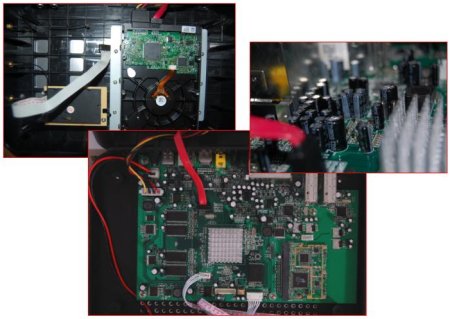
Myka (internal views)
(Click to enlarge)
The Myka appliance boots Linux from 16MB of flash, and has 256MB of DDR memory. It includes two USB ports, says Myka, as well as HDMI, composite, S-video, and S/PDIF ports for linking up to a TV. It offers video-out at up to 1080i, and supports 4:3 and 16:9 aspect ratios, says the company.
The company has disclosed more details on the devices, and much more additional information on both hardware and software will be posted in the weeks to come, said Lovy. “We think there's an opportunity to enhance the product through the open source development community, and we hope to build up a developer base,” said Lovy.
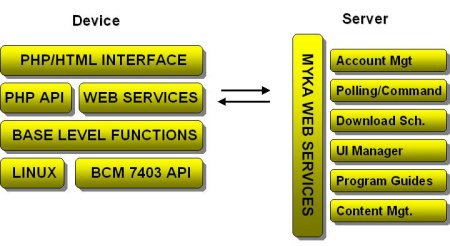
Myka architecture
(Click to enlarge)
Myka's architecture is divided into server and client subsystems. The server supplies business logic and rules, and overseas account management, scheduling, adding channels and interfaces, and creating new program guides, says the company.
The device subsystem itself, meanwhile, “was purposefully made very dumb,” says Myka. Its interface, download scheduling, and updating are all controlled by the remote server. The device can play local files on its own, but downloads are managed by the server.
“The device is more of a slave than most,” said Lovy. “The UI and business rules all come from the server, so the idea is that as you create different interfaces and applications, they can be downloaded easily to the device. Once you have set up a developer's account, you can essentially point a Myka box at a channel, and download code and interfaces directly to the box.”
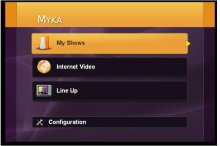
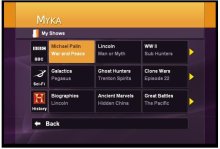
Myka interface
(Click on either to enlarge)
Major device-side components are said to include:
- PHP/HTML interface — The interface is expressed solely by HTML, PHP, and JavaScript, which the company says makes it easier for open source development.
- PHP API — PHP calls perform tasks such as playing a video or starting a BitTorrent download. The calls will be published and extensible, said Lovy. “We are gathering PHP calls as quickly as we can, and will post them soon,” he added.
- Web services — Communication to the Myka server uses web service calls, periodically polling the server for new commands such as file downloads, UI updates, and adding new services.
- Base-level functions — Basic device controls for playing videos, etc.
- Linux and BCM7403 API — Core Linux functions have been “abstracted away,” says Myka, and exposed through the PHP API. The device currently runs a version of Red Hat Linux, said Lovy.

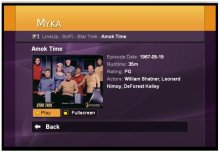
Myka Guide screen, and Star Trek content screen
(Click on either to enlarge)
The Myka user interface (UI) is rendered in HTML, with Flash support being planned, says Myka. Designed to be displayed on a TV and operated with a remote control, the browser interface offers full HTML support, with CSS and JavaScript to control behavior and appearance, and PHP supporting dynamic elements, says the company.
BitTorrent survives Goliath
BitTorrent gained popularity among file sharers in the late 90s because its decentralized distribution protocol allows network usage costs to be borne by downloaders rather than file originators. It eliminated bottlenecks, privacy issues, and shutdown concerns associated with centralized systems like Napster, and created a situation where the more popular a given file becomes, the faster it will download.
BitTorrent was once associated with illegal media file downloads, but in recent years, BitTorrent, the company, has been cutting deals with various entertainment content companies including 20th Century Fox, MTV, Paramount, and Warner Brothers. The deals let the company provide licensed, downloadable, and ad-supported streaming content for its Torrent Entertainment Network (TEN) entertainment site. The site now boasts over 160 million installed clients, says BitTorrent, and the company also licenses its technology to other companies such as Myka.
BitTorrent has managed to avoid copyright infringement lawsuits, but over the last year, it has tangled with another industry giant: Comcast. After Comcast was shown to be sabotaging BitTorrent users' full access to bandwidth on its broadband cable network, a class-action lawsuit was filed against the cable giant. Comcast, meanwhile, accused the company of fostering a technology that hogs bandwidth and slows down Internet connections for others. Comcast claims the technology accounts for half of its Internet traffic.
Last Spring, however, the two companies struck a deal based on a compromise. Comcast maintains the right to slow (but not halt) traffic for users who consume excessive bandwidth, but is not allowed to discriminate by type of application (such as file-sharing) or by company.
Availability
The Myka TorrentTV devices are available for order now, with shipment in four to six weeks, says Myka. The prices, shown here with product names referring to available storage in gigabytes, are lower than originally announced: $280 (Myka 80), $320 (Myka 160), $390 (Myka 500), and $360 (1TB Developer's Edition, normally $460). For information may be available here.
This article was originally published on LinuxDevices.com and has been donated to the open source community by QuinStreet Inc. Please visit LinuxToday.com for up-to-date news and articles about Linux and open source.